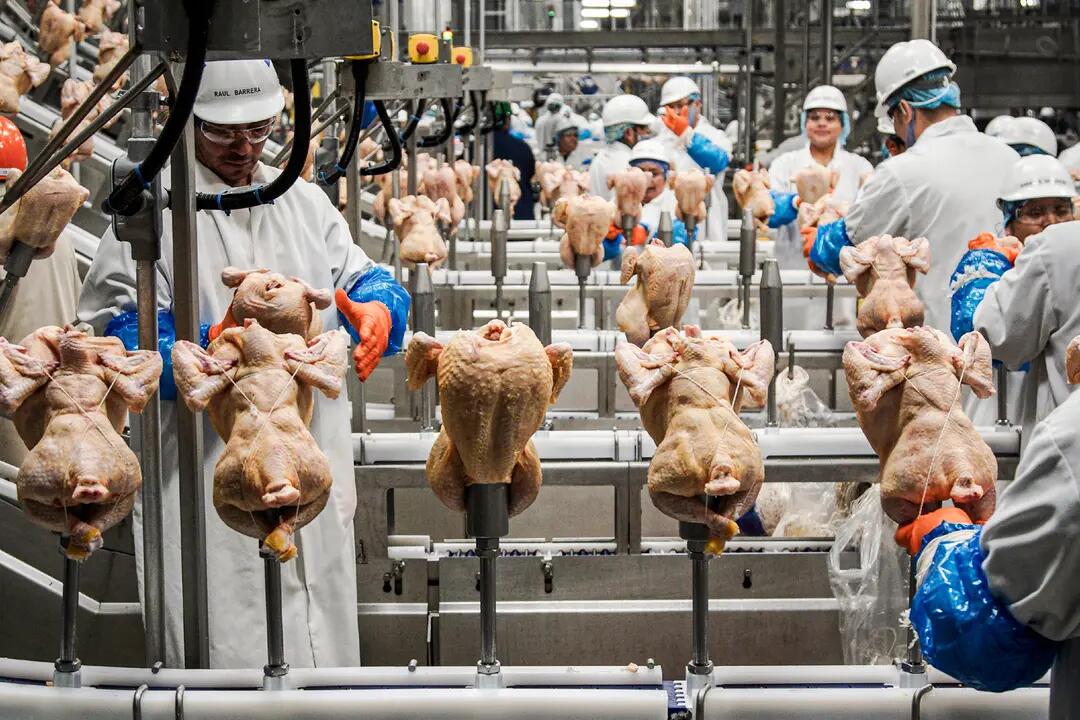by Darlene McCormick Sanchez via The Epoch Times (emphasis ours),
Food prices—especially meat and poultry—have skyrocketed in the past four years and could be exacerbated further next year when new EPA rules for meat processors go into effect.
The U.S. Department of Agriculture’s Food Price Outlook for September reported that beef and veal prices had increased for six straight months, and predicted they will rise 5.2 percent overall in 2024. Poultry prices also rose, although by a smaller percentage, and are expected to rise more before year’s end.
The report traced the rise to factors including pandemic-related supply chain disruptions and the worst inflation since the 1980s.
Next year could see still higher meat and poultry prices at the grocery store, analysts say. That’s because an Environmental Protection Agency (EPA) proposal is expected to put some meat processors out of business, resulting in potential job losses and supply chain disruptions.
The EPA announced a proposed rule change governing effluent, or wastewater, limits for meat and poultry processors in January of this year, followed by public comment in the spring.
The agency’s final rule will go into effect in August 2025.
The proposal has met with opposition from dozens of states, industry stakeholders, and policy experts, who fear it will harm the industry, the food supply, and consumers.
The proposed changes are spurred by lawsuits filed by a coalition of 13 environmental organizations. In 2019, the groups challenged the Trump administration under the Clean Water Act for not updating aging water pollution control standards for slaughterhouses and meat processing plants.
In response, the EPA pledged to strengthen its regulations, without implementing changes. In December 2022, a second lawsuit was filed, resulting in the current proposal.
The proposed rule contains three possible options for reducing wastewater discharges from slaughterhouses and poultry processors through water filtration technology.
Benefits and Drawbacks
The EPA estimates that the new rules would reduce pollutants discharged through wastewater from processing facilities by about 100 million pounds per year.
The proposed rules would establish tighter limitations for nitrogen released into the environment by large processors and, for the first time, would limit phosphorus.
The rules would apply to processors directly discharging wastewater into bodies of water, and, for the first time, would also apply to those indirectly discharging wastewater via water treatment plants.
In another first, the new rules would establish pretreatment standards for oil and grease, total suspended solids, and biochemical oxygen demand.
The EPA solicited comments on its preferred option and on two other proposals, which would apply pollutant limitations to smaller processors and tighten restrictions on wastewater pollutants.
About 850 of some 5,000 facilities would be impacted by the preferred rule changes, the agency said. Those include large facilities processing more than 50 million pounds of meat per year and more than 100 million pounds of poultry per year.
The EPA estimates that under its preferred option, at least 16 facilities will be forced to close, impacting at least 17,000 jobs. At the top end, the EPA estimates up to 53 plants could close.
Prices for beef, chicken, turkey, and pork products are expected to increase slightly while availability of meat and poultry is expected to decrease slightly, according to the agency.
In an email to The Epoch Times, EPA scientist Michael Nye called the proposed regulations “economically achievable” and flexible enough to allow processors to find “even lower-cost compliance options.”
The agency’s literature said cutting down on wastewater pollution from processors would reduce exposure to pathogens and toxins, improve aquatic habitats, and enhance recreational and tourism use of lakes and rivers.
Less pollution would combat climate issues and work to address pollution in poor and minority communities, according to the EPA.
The agency estimated the “total monetized benefits” of tightening the wastewater standards to be between about $90 million and $180 million annually.
States Push Back
A coalition of attorneys general from 27 states—led by Kansas and Arkansas—have argued that the rule change amounts to federal overreach.
Part of the rule change would regulate processors that release wastewater into treatment plants, which is unnecessary, they stated in a March letter to the EPA.
The states say that the EPA currently regulates only 171 of the meat and poultry product facilities in the United States. Those are facilities that directly discharge wastewater into bodies of water—not facilities that release it indirectly by discharging it to sewers or municipal sewage treatment plants.

By also including facilities that indirectly discharge wastewater, the regulation would expand to encompass some 3,879 facilities, according to the states. The EPA “has never before claimed such sweeping authority to regulate indirect discharges,” they stated, calling the proposed rule “not only costly but also unlawful.”
Federal statistics show that inflation remains high, they said, and shutting down meat and poultry processors would only aggravate the problem.
The attorneys general also questioned the data on which the EPA’s proposal is based.
“It appears that EPA is relying primarily on data put together by the groups that were suing them to come up with this rule,” they said.
The EPA cited plaintiff findings such as those from a 2018 Environmental Integrity Project report to support the proposed changes.
“Tyson Fresh Meats of Dakota City, Nevada, releases as much as 3,084 pounds of nitrogen per day into the Missouri River, a level approximately equal to the waste load of 132,000 people,” the agency said in technical documents citing the 2018 report.
No comments:
Post a Comment
Note: Only a member of this blog may post a comment.